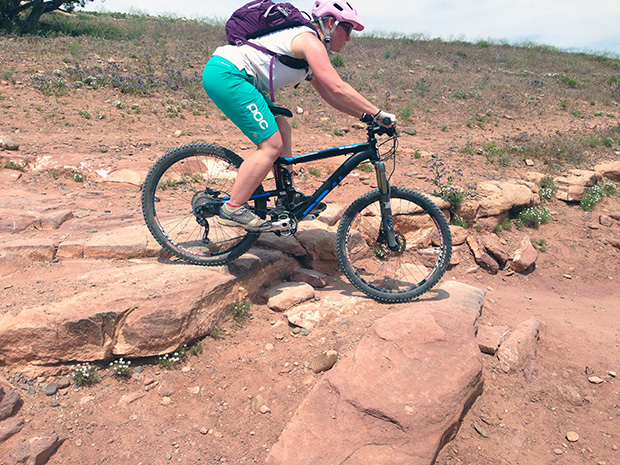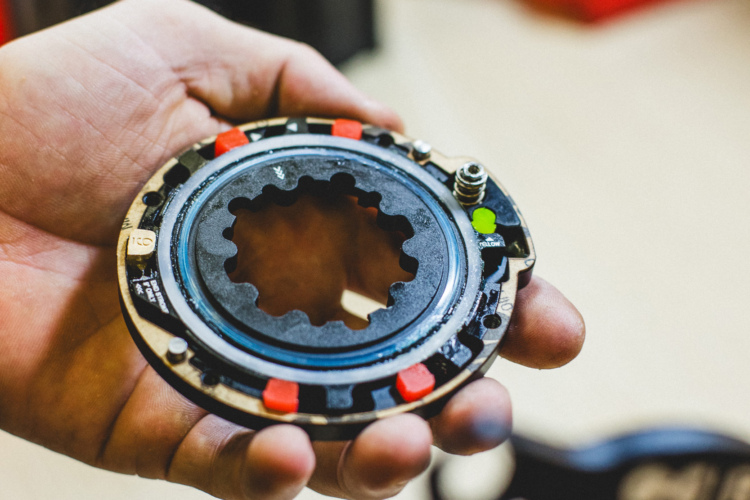My intro to the Niner JET 9 Alloy was short and sweet. I received the bike just days before I left for the Trans-Sylvania Epic in May. After just one shakedown ride, I made a bunch of spec changes and then slapped it on the roof of my car and headed to Pennsylvania for a week of stage racing.

Component Changes
Why change components? Well, for one, I’m a serial tinkerer when it comes to my bikes. More often than not, I have at least one bike out of commission because I stole something off of it to put on another bike. And for another, I wanted to set up the JET 9 closer to how my own bikes are spec’d.

That meant ditching the front derailleur and shifter, along with the chainrings. In their place, I put on a Hope Retainer Ring (Hope’s take on narrow-wide). The stock Arch EX wheels were swapped out for a set of American Classic’s Wide Lightnings, shod in Maxxis tires instead of the original Schwalbes. There’s nothing wrong with the Arch EX wheels at all, but the American Classics were much wider and much lighter. Seeing as how I was going to be spending long days in the saddle, I wanted the lower weight and cushy footprint they provided.
The stock grips made my hands go numb, so I put on a set of Chromag’s Squarewave lock-ons in their place. And finally, I added a bottle cage.
Well…
Maybe I changed a couple of other things too.
Component Report
As expected, the Shimano XT drivetrain worked flawlessly throughout the test. Shifting was quick and crisp. I did, however, have an issue with the front brake. Out of the box, there was a serious lack of bite. Those of you that have ridden with Shimano brakes know that they tend to be very powerful and have a very “on/off” feeling. Well, the back brake worked just fine, so the discrepancy between the front and rear made for a very odd feel.

And before you ask, yes I did take the time to properly bed in the pads. My best guess is that the brake pads somehow became contaminated during shipping. I pulled the pads out and sanded and cleaned them, along with the rotor. That didn’t seem to make any difference. I was halfway through the week in PA before the front started working properly.
The final changes made to the Niner came after the second stage of the race. The little RockShox SiD up front performed quite admirably. When I first saw its spindly stanchions and 100mm of travel, I expected it to be noodlier than a Trey Anastasio guitar solo. I was pleasantly surprised by its stiffness and performance, though. That said, it wasn’t quite up to the repeated beatings that the trails in PA dish out. If you’re using the JET 9 as a purely XC machine, the SiD will suffice. If you want to push it into trail bike category, it’s under-gunned.

So, out came the allen wrenches, off went the SiD, and the SR Suntour Aion was put on in its place. The Aion sports 120mm of travel and 34mm stanchions. It’s a burly fork, and combined with a wider bar and shorter stem, it unlocked the true potential of the JET 9.
Niner does offer JET 9 build kits with a 120mm fork and I would definitely suggest going that route.
The Ride
With all the spec changes I made, the bike became a legit singletrack tamer. The longer fork slackened the head tube angle a bit, making the bike more stable at speed. The shorter stem and wider bar allowed me to dive into the chunky trails of PA with newfound confidence.

The rear suspension is excellent. It’s a Niner-patented design they call CVA–if you want an in-depth explanation of how it works, visit Niner’s site, here. I did find I had to run quite a bit more sag than expected, especially for an XC bike. In the end, I found around 30% sag to be the sweet spot for me and my riding style. Typically, XC bikes run 20% sag, and at most 25%. 30% is more in line with what you’d run on a long-travel trail bike.
I was certainly using all the travel–the O-ring was blown off regularly–but the bike never bottomed out harshly. With the softer suspension setup the bike easily followed the contours of the trails, but still pedaled extremely well. CVA is one of the best overall suspension designs I’ve ridden.
Final Thoughts
With all the spec changes I made, you might think that there was something wrong with the stock setup. There isn’t. Two-by drivetrains still definitely have their place, and I had no shifting issues when I rode the Niner that way. The SiD may not have been up to the task of uber-rocky trails, but honestly, that’s not what the fork was intended for. It’s meant to be an XC race fork and in that capacity, it works very well. The grips weren’t to my liking, but that’s a personal preference.

Overall, the JET 9 is an excellent XC/short-travel trail bike. As I mentioned above, I would recommend going with one of 120mm fork build kits, especially the one with the Pike. However, it looks like the JET 9 Alloy may be going the way of the dodo as it has disappeared from Niner’s website. There are two levels of carbon JET 9s available, though, so fear not. Considering the fact that the JET 9 Carbon with the same XT build as this bike is only $300 more, it’s no wonder the alloy version is getting dropped.
MSRP for JET 9 Carbon, XT build: $4,500




















0 Comments